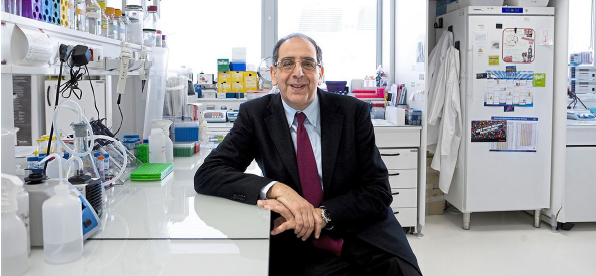Sight + Sound, Fall 2021
After 40 years of total blindness, a 58-year-old French man saw stripes in a crosswalk. He was also able to reach out and touch a large notebook, a staple box, and hydroalcoholic gel on a table and discern whether two or three glass tumblers were before him.
This newfound ability didn’t just happen overnight. A new kind of gene therapy called optogenetics finally paid off after 13 years of research.
The breakthrough study published in the May 2021 issue of Nature Medicine detailed how a team of researchers led by Dr. José-Alain Sahel, Chair and Distinguished Professor of the Department of Ophthalmology at the University of Pittsburgh School of Medicine, delivered a protein called ChrimsonR directly to the retina to make it more receptive to light.
This was accomplished by genetically manipulating a common non-pathogenic virus so that it carries the protein. After about four months, the ganglion cells in the retina could transform and absorb light. Shapes and shadows on the amber color spectrum became visible.
In other words, optogenetics was used to make the top layer of ganglion cells at the front of the retina photosensitive, bypassing the non-functioning degenerated layer of photoreceptors.
There are caveats, of course. So far, the treatment had only proven successful in one patient (the only one trained before the project was interrupted due to COVID), and in only one eye, with the help of special goggles to deliver sufficient and safe levels of light. The goggles also scan the field of view, register light changes in each pixel, and send pulses of amber light to the eye.
The 58-year-old man’s retina was given five months to accept the treatment, followed by seven months of training with the goggles. Prior to the injection, he could not visually detect any objects with or without the goggles, nor could he after injection without the goggles. According to the study abstract, “This is the first reported case of partial functional recovery in a neurodegenerative disease after optogenetic therapy.”
The significance of this work will be recognized at the Falling Walls Conference in November, an event that commemorates the fall of the Berlin wall that the BBC calls a convening of “the brightest minds on the planet.” Dr. Sahel is one of seven winners from 1,000 nominations in 115 countries for Science Breakthroughs of the Year. His award in the Life Sciences category is “Breaking the Wall to Restoring Vision for Retinal Degeneration.”
Meanwhile, more research is needed to determine dosing levels, improve the goggles and training to use them, and consider the best treatment timing. The trial is now expanding, with new patients being treated and trained in Paris and Pittsburgh. Right now, the trial only patients with very advanced disease. Additionally, researchers cautioned, the patient’s vision is not expected to get to the point of reading or recognizing faces. Yet this is undeniably a significant achievement that is expected to have long-lasting, maybe even permanent, results for patients with retinitis pigmentosa.
